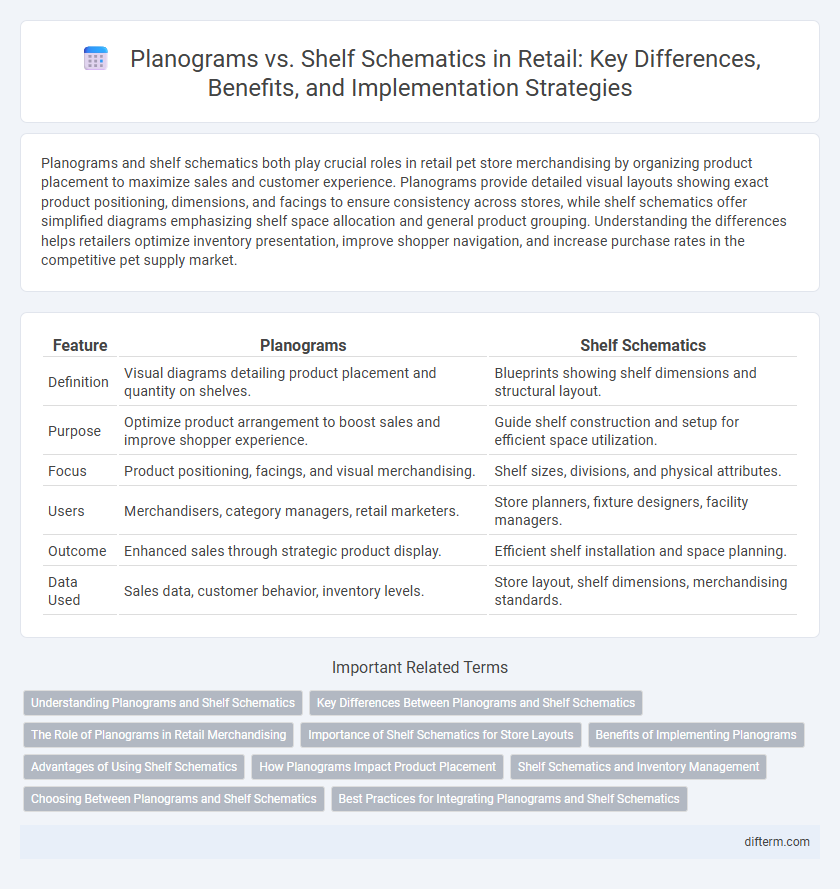Planograms and shelf schematics both play crucial roles in retail pet store merchandising by organizing product placement to maximize sales and customer experience. Planograms provide detailed visual layouts showing exact product positioning, dimensions, and facings to ensure consistency across stores, while shelf schematics offer simplified diagrams emphasizing shelf space allocation and general product grouping. Understanding the differences helps retailers optimize inventory presentation, improve shopper navigation, and increase purchase rates in the competitive pet supply market.
Table of Comparison
| Feature | Planograms | Shelf Schematics |
|---|---|---|
| Definition | Visual diagrams detailing product placement and quantity on shelves. | Blueprints showing shelf dimensions and structural layout. |
| Purpose | Optimize product arrangement to boost sales and improve shopper experience. | Guide shelf construction and setup for efficient space utilization. |
| Focus | Product positioning, facings, and visual merchandising. | Shelf sizes, divisions, and physical attributes. |
| Users | Merchandisers, category managers, retail marketers. | Store planners, fixture designers, facility managers. |
| Outcome | Enhanced sales through strategic product display. | Efficient shelf installation and space planning. |
| Data Used | Sales data, customer behavior, inventory levels. | Store layout, shelf dimensions, merchandising standards. |
Understanding Planograms and Shelf Schematics
Planograms are detailed visual representations used in retail to optimize product placement on shelves, aiming to maximize sales and improve customer experience. Shelf schematics provide a technical layout focusing on shelf dimensions, fixtures, and spacing to guide precise product arrangement. Both tools are essential for inventory management and merchandising strategy, ensuring consistency and efficiency in store presentation.
Key Differences Between Planograms and Shelf Schematics
Planograms are detailed diagrams specifying the precise placement and quantity of products on retail shelves to maximize sales and optimize inventory, while shelf schematics provide a broader layout showing shelf dimensions and configurations without specific product assignments. Planograms incorporate sales data, consumer behavior, and product facings to drive merchandising strategies, whereas shelf schematics primarily guide store fixtures and physical shelf arrangements. The key difference lies in planograms' focus on product placement optimization versus shelf schematics' emphasis on spatial design and shelf structure.
The Role of Planograms in Retail Merchandising
Planograms are essential tools in retail merchandising, precisely detailing product placement to maximize sales and optimize shelf space efficiency. They guide store layout decisions based on consumer behavior data, ensuring consistent brand presentation and inventory management across locations. Compared to shelf schematics, planograms provide a more dynamic, data-driven approach to product organization that drives shopper engagement and enhances overall store performance.
Importance of Shelf Schematics for Store Layouts
Shelf schematics play a crucial role in retail store layouts by providing detailed visual blueprints that guide product placement and optimize space utilization. Unlike planograms, which focus primarily on product adjacency and merchandising strategy, shelf schematics integrate structural elements such as shelving dimensions and fixture specifications to ensure efficient traffic flow and accessibility. This integration enhances shopper experience and maximizes sales potential by aligning physical store constraints with merchandising goals.
Benefits of Implementing Planograms
Implementing planograms enhances product placement by using data-driven layouts, which maximize shelf space efficiency and boost sales per square foot. Planograms improve inventory management by ensuring consistent product visibility and facilitating quick restocking. These tools also increase shopper satisfaction through organized displays that streamline the purchase decision process.
Advantages of Using Shelf Schematics
Shelf schematics enhance retail merchandising by providing detailed, scalable layouts for product placement that improve inventory management and boost sales. These visual tools facilitate consistent store presentations and enable quick adjustments to accommodate seasonal promotions or new product introductions. Shelf schematics also streamline staff training and reduce planogram compliance errors, leading to increased operational efficiency.
How Planograms Impact Product Placement
Planograms significantly influence product placement by strategically organizing items to maximize visibility and sales within retail spaces. They optimize shelf space by detailing precise product locations based on consumer behavior, inventory levels, and sales data. Effective planograms enhance shopper experience and drive higher turnover by prioritizing high-demand products and promotional items in key locations.
Shelf Schematics and Inventory Management
Shelf schematics provide a detailed visual representation of product placement, optimizing shelf space to enhance inventory management accuracy. By aligning shelf schematics with real-time inventory data, retailers can reduce stockouts and overstock situations, improving turnover rates. Integrating shelf schematics into inventory management systems streamlines replenishment and boosts overall retail efficiency.
Choosing Between Planograms and Shelf Schematics
Choosing between planograms and shelf schematics depends on the detail and purpose of your retail display strategy. Planograms provide a precise, data-driven layout for product placement to optimize sales, while shelf schematics offer a more general visual guide for store staff to arrange items. Retailers seeking to maximize inventory management and shopper engagement typically prefer planograms for their strategic benefits.
Best Practices for Integrating Planograms and Shelf Schematics
Integrating planograms and shelf schematics requires detailed accuracy in product placement to maximize space utilization and enhance customer experience. Using digital tools for real-time updates ensures synchronization between planogram designs and shelf schematics, reducing stockouts and overstock risks. Collaborating with merchandising, inventory, and marketing teams aligns visual displays with sales strategies, driving increased revenue and operational efficiency.
Planograms vs Shelf Schematics Infographic

 difterm.com
difterm.com